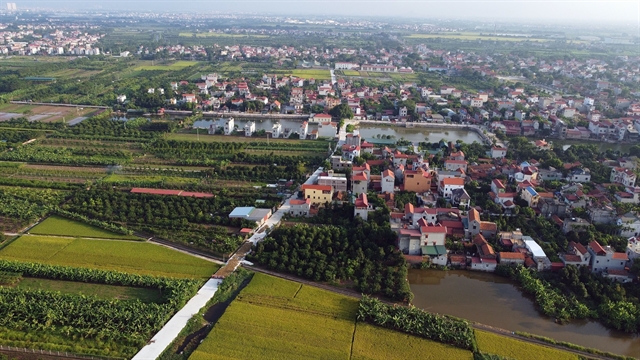 Society
Society

 |
| An overview of Đan Phượng District in suburban Hà Nội. — VNA/VNS Photo Huy Hùng |
HÀ NỘI — Peri-urban villages in Hà Nội have been greatly affected by rapid urbanisation and managing the changes to adapt to the new situation and maintaining their traditional identities is a difficult problem for municipal authorities.
Names of Kim Liên, Thanh Lương, Ngọc Hà, Nhân Chính and Yên Hòa now are known as inner-city wards with dense population, vibrant trade and spacious houses, but in the past they were suburban villages in Hà Nội.
For nearly 30 years, these peri-urban villages have naturally integrated with the urban area, becoming streets, blurring the boundary between villages and streets.
Together with them, a series of suburban districts have been converted to inner-city districts, from Cầu Giấy, Tây Hồ, Thanh Xuân to Hoàng Mai, Long Biên, Bắc Từ Liêm and Nam Từ Liêm.
Architect Trần Huy Ánh, from the Hà Nội Architects’ Association, said that suburban areas affected by urbanisation have faced many inadequacies in infrastructure, society, landscape, and ecological environment.
When converted from a village to a street, the villages were increasingly drawn into rapid modernisation and as a result, many elements of the old villages could not adapt in time, creating chaos in the villages.
People are only interested in building infrastructure, Ánh said.
Low-rise buildings have turned into high-rise ones, roads were expanded, land prices were increased.
Fields and gardens became valuable real estate in a short time.
People in villages gradually lost their fields and agricultural jobs.
The village structure and culture were changed. Drainage structures are levelled.
There is no research or policy to guide and help people limit or find ways to minimise the negative impacts of these changes.
Therefore, peri-urban villages had really been hurt over the past time, he said.
Architect Phạm Thùy Linh from the Hà Nội Architectural University also said that new residential areas and urban areas would continue to be built on farmland, next to old villages without any connection to the landscape.
Heritage sites will disappear or continue to exist alternately within the old villages and new urban space.
Their form would change following the needs of villagers and urban pressures, she said.
Balance to adapt
Finding a solution to balance modern life and preserving old identity is a problem for management agencies and the community.
Currently, Hà Nội is implementing two big schemes, including Hà Nội Planning for the 2021-30 period with vision to 2050; and Adjusting the General Planning of Hà Nội to 2045 with a vision to 2065.
The schemes determine and classify the areas to become districts and the ones to continue to be agricultural land.
Based on the classification, the city will have appropriate policies and models in the coming period.
Architect Đào Ngọc Nghiêm, deputy chairman of the Việt Nam Urban Planning and Development Association, said that based on the classification, appropriate models would be selected.
For example, stable agricultural areas will follow a model of both agricultural production and agricultural tourism. Craft villages will be innovated to have specific products. Villages associated with the urban area for a long time should have reasonable policies for further development.
Many experts also believe that, in the face of urbanisation and its negative impacts on peri-urban villages, if well preserved, the villages can be considered valuable parts and safe zones in the city’s overdevelopment.
Hà Nội currently has many suburban villages. Instead of quickly deciding to become urban areas, the authorities need to be calm and cautious to find a reasonable development method.
Architect Ánh said that peri-urban villages had extremely great value.
They should be considered ecologically autonomous units, serving as a buffer zone to reduce population pressure in crowded areas.
The city should count peri-urban villages as human museums, which are long-standing settlements of the community and containing sustainable historical traditions and culture.
They will supplement the value of urban areas in the urbanisation process. — VNS




